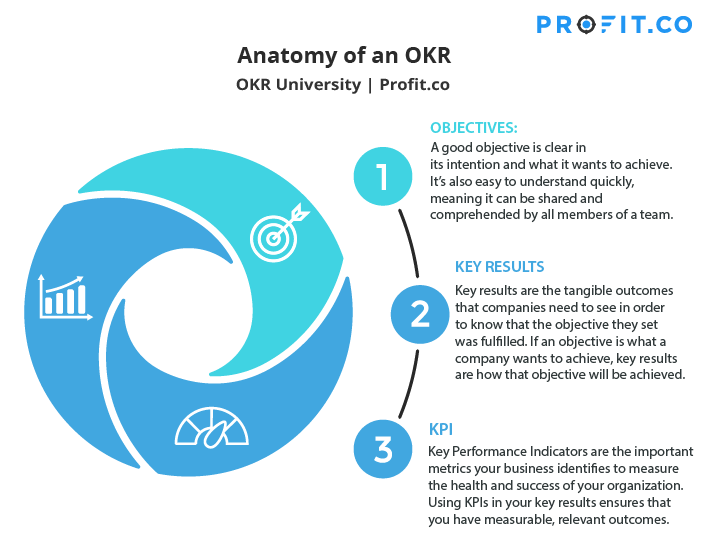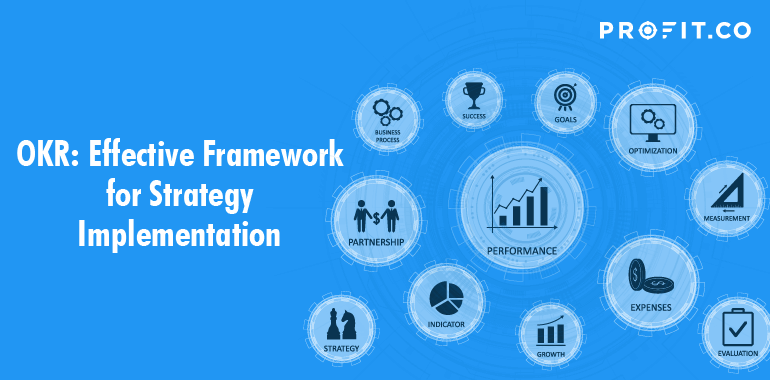A good organization can often be defined by one thing – good organization. The strategies and methodologies that companies use to achieve their goals aren’t just a clever way to impress investors and keep management busy. In a world where efficiency can create output that goes above the available resources, business leaders are constantly evaluating the process they use to hit their targets.
There’s no shortage of remarkable ideas, what’s missing is the will to execute them.
An objectives and key results (OKR) based framework is popular for exactly that reason. OKRs, at least on their own, aren’t a strategy. They’re a way of organizing various strategies around well-defined goals and measuring success through internal benchmarks that have been in place since the planning phase. However, OKRs can help you achieve more, and progress towards your goals faster.
While that bird’s eye overview of OKRs touches on why they’re important, a better way to explain them is to break down what they are. So in the world of metrics, resource management, strategy implementation and goal setting, what are OKRs, and how can they benefit such a wide scope of businesses?
Why is a strategic framework necessary for an organization
Without a framework, it’s important to organize a company’s structure into something that generates consistent results. Even failed projects benefit from OKRs, which track performance in a way that highlights where the bottlenecks in a process are. At the best of times, OKRs don’t just serve as a strategy framework; they embed themselves in the organization as a motivational force.
One of the most powerful things about OKRs is flexibility. A number of business strategies can be comfortably fitted within an OKR framework. More importantly, flexibility creates the opportunity for scaling. This means that OKRs can be implemented in small and medium-sized businesses to create results in the present while also creating a pathway for growth.
This dual-pronged approach allows companies to set short, medium and long term goals. In doing this, tasks, objectives and performance metrics can be adjusted at a macro (company/organization) and micro (individual departments/teams) level.
By utilizing the existing chain of command within a business, OKR can offer leaders a solution to multiple problems. By virtue of working (at least in part) as a resource management tool, OKRs maximize available capital, labor, time, networks, supply chains and distribution channels.
Do you want a scalable, agile software solution for your OKRs? Sign up for Profit.co completely free today and start achieving!
How OKRs act as an excellent strategic network
Objectives and key results are two halves of the same concept. Still, each half has to be assessed and created individually while also keeping the corresponding half in mind. Objectives are similar but fundamentally different to key results. Similarly, key results often get confused with another term: key performance indicators (KPIs).
Understanding OKRs means understanding all three concepts. So let’s take a look at them individually while also breaking down how they fit into the overall framework.

Objectives
You can swap out “objectives” for “goals”, and this portion of the framework would still make sense. The best practice, of course, is to hold firm to objectives. This isn’t just so the acronym sticks. It goes back to the key function of objectives in the first place: clarity and direction.
A good objective is clear in its intention and what it wants to achieve. It’s also easy to understand quickly, meaning it can be shared in quick succession because the information within it is designed to be that way. So, in order to be effective, the objective needs to be clear, translatable, and get everyone facing the right direction.
Still, once everyone’s looking the right way, they have to move forward. How do they do this?
Key results
Unlike KPIs, key results aren’t about tracking processes – they’re about creating them. Key results are the tangible outcomes that companies need to see in order to know that the objective they set was fulfilled. If an objective can be defined as what a company wants to achieve, key results are how that objective will be achieved.
Writing strong, well-structured key results doesn’t have to be complicated. Key results and SMART goals have a lot in common– so you can take any previous goal-setting skills you have and learn to write OKRs that help you focus, measure, and achieve more.
Key performance indicators
So, you have your objective, which everyone within the organization is aiming to hit. Then you have your key results, which are the pre-planned strategies and outcomes an organization defines in order to meet the objective. How do you check if things are going according to plan? By using key performance indicators, of course.
Using KPIs in your key results is a great way to ensure that you have measurable, relevant outcomes. Like key results, KPIs should be defined in the planning stage.
Effectiveness of OKR as a strategy implementation tool
OKRs are most effective when there is an understanding of how they work at every level of an organization. This means breaking the framework up to allow smaller, modular teams to take ownership of their own key results while working towards the same objective.
The objective needs to be understood by everyone in the organization. Key results will differ depending on the roles of individuals and teams, so those only need to be understood by people working directly with those processes. By doing this, managers can allow the objective to serve as a guide and compass at a macro level, while teams and key individuals deal directly with points of execution they’re responsible for.
This also creates a level of accountability, which weeds out bad practices like blame-shifting, missed deadlines, bottlenecks, unclear messaging and a lack of support.
Final Thoughts
OKRs have been around in some form for decades– however, the businesses they’re applied to now are now bigger, more complex, and operating at least in part in a digital sphere that didn’t exist 60 years ago.
This translation of OKR best practices to contemporary models is a direct testament to how effective OKRs can be as a framework for strategy implementation.
To learn more about how you can use OKRs to implement your strategy and achieve more, schedule a free demo with our OKR experts today!
Ready to start your OKR Journey for FREE?

